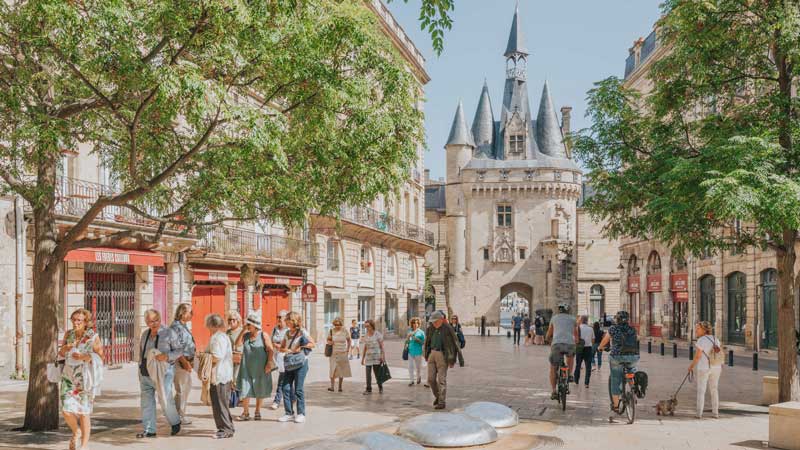
Located between the mouths of the River Peugue and River Devèze, two main rivers or Bordeaux, navigable at one time up to the middle of the port city in southwest France, the City Gate Cailhau was once the main entrance into the city of Bordeaux from the port, with direct access to the Palais de l’Ombrière, the residence of the Dukes of Guyenne and the future King of France Louis VII, when he came to Bordeaux for his marriage with Eleanor of Aquitaine in 1137, then the seat of the Parliament of Bordeaux from 1462.
The first gateway to the city that had been built within the city walls was destroyed and replaced by the tall and majestic City Gate Cailhau, one of the most beautiful of the six gates of Bordeaux, rebuilt at a strategic geographical point, between the mouths of the tributaries of the River Garonne, offering a wonderful panoramic view of the Pont de Pierre bridge from under its high conical roofs.


Coincidentally, the inauguration of the gate, containing several defensive features of protection from external attacks and possible popular revolts, was followed by the victory of Charles VIII in the Battle of Fornovo on 6 July 1495, in which the Archbishop of Bordeaux, the Cardinal of Epinay and part of the Bordeaux nobility also participated and France captured Naples. To commemorate the victory, the City Gate Cailhau, facing the Palais de l'Ombrière and forming a royal entrance, was dedicated to Charles VIII by the city councillors and decorated it with the marble statue of the king at its top, holding a globe and sceptre, flanked by the statue of the Cardinal of Epinay on his left and Saint John the Baptist on his right.
In addition, the façade of the gateway on the city side contained France’s fleur-de-lis coat of arms, carried by two angels. Unfortunately, the statues were vandalized during the Revolution in 1793 and were replaced much later, in 1880, by stone copies.


Nobody is certain about the origin of the name of the gate, but it is considered that the city gate was named after the Quai du Caillou or the quay of stone, the first cobblestone-paved quay along the Garonne River and the gate erected in front of the quay of Caillou naturally took its name. The possibility has a strong base, because in those early days, long-distance boats brought in loads of stones as ballast and left it behind when they set off with the local wine.
These tons of stones were used to pave the quay and even the city and the foundations for its walls However, it is also argued that it could be a reference to Les Cailhau, the medieval bourgeois family of Bordeaux, a family from which came several mayors of Bordeaux.

It is estimated that the initial architect of the gate was probably Raymond Macip and after that, it was reworked several times, especially during the widening of the bay by the architect Charles Dardan in 1753-1754. But it was Charles Durand, who completely restored the building from 1880 to 1890 and also freed it from the adjoining buildings. The City Gate Cailhau was part of the Red Ball project in 2010, when artist Kurt Perschke put a giant red ball in the middle of the gate. The Cailhau Gate, also called the Palace Gate, reflects the characteristics of the Gothic-Renaissance transition, which is evident from its arches above the bay windows, its conical roof and the elegant turret. The facade facing the Quays exhibits a theatrical scene representing two angels bearing a coat of arms with three fleurs-de-lis or lilies, symbolising purity and chastity, topped by a royal crown placed on a palm. The 115 feet (35 m) tall Porte Cailhau, resembling a castle-like exterior and built of limestone, which was once the main gate to the city, is equipped with arrow slits on both sides and has two floors. The first floor is free and contains a small display relating to the history of the gate and the upper floor offers a superb view of the port, Pont Pierre and Bordeaux’s city rooftops.

The Porte, which houses the library of the Bordeaux Archaeological Society, also has a museum, created by the Bordeaux Archaeological Society in 1907, containing several remains of the Gallo-Roman era, maps, seals, letters, travel diaries, as well as pottery, earthenware, glassware and portraits of prominent Bordeaux residents. In addition, it also contains a silk dress owned by the famous Madame Tallien, a Spanish born French noble, a superb ambassadress of Parisian fashion and one of the chief organisers of the Thermidorian Reaction, which resulted in the fall of Robespierre and the collapse of the Reign of Terror in France.